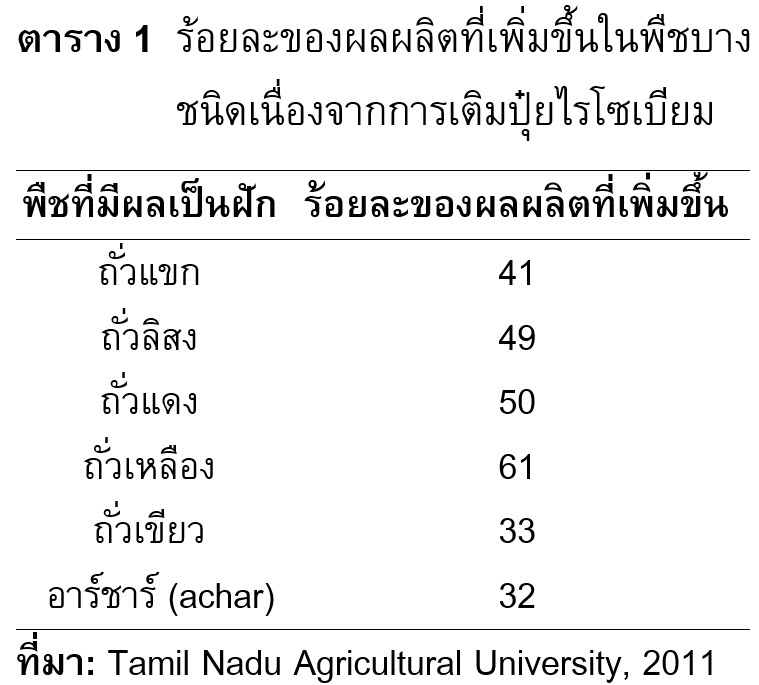การนำจุลินทรีย์มาใช้ประโยชน์ในระบบเกษตรกรรมแบบยั่งยืน
Main Article Content
Abstract
Arun Chanchaichaovivat, Suwinai Kirdtabtim and Somkiat Phornphisutthimas
รับบทความ: 3 กันยายน 2559; ยอมรับตีพิมพ์: 4 พฤศจิกายน 2559
บทคัดย่อ
การคัดเลือกจุลินทรีย์ที่มีประโยชน์ต่อระบบการเกษตรแบบยั่งยืนที่ได้รับการพัฒนาจนสามารถนำไปใช้เพิ่มผลผลิตอย่างได้ผลและเป็นที่ยอมรับของเกษตรกรในปัจจุบัน โดยทั่วไปนิยมนำจุลินทรีย์ไปใช้ในรูปของปุ๋ยชีวภาพ สารสกัดส่งเสริมการเจริญเติบโตของพืช และสารกำจัดศัตรูพืช ซึ่งจุลินทรีย์เหล่านี้ต้องมีสมบัติพิเศษคือ สามารถตรึงแก๊สไนโตรเจนจากอากาศมาเปลี่ยนเป็นสารประกอบที่พืชสามารถนำไปใช้ได้ หรือมีความสามารถในการย่อยสลายสารอินทรีย์ในดินได้อย่างรวดเร็ว ทำให้พืชสามารถดูดซึมสารอาหารเข้าสู่ระบบรากได้ดี จุลินทรีย์บางชนิดสร้างฮอร์โมนหรือวิตามินส่งเสริมการเจริญเติบโตของพืช บางชนิดดำรงชีวิตเป็นปฏิปักษ์ต่อจุลินทรีย์ก่อโรคพืชโดยสร้างสารปฏิชีวนะต่อต้านจุลินทรีย์ก่อโรค แก่งแย่งพื้นที่หรือสารอาหารจากจุลินทรีย์ก่อโรค หรือสามารถกระตุ้นภูมิต้านทานโรคของต้นพืชโดยไม่ทำอันตราย จุลินทรีย์เหล่านี้ได้นำมาใช้เป็นสารชีวภาพกำจัดศัตรูพืชในรูปของเซลล์หรือสารสกัดจากเซลล์ อย่างไรก็ตาม การใช้จุลินทรีย์ให้เกิดประโยชน์อย่างแท้จริง เกษตรกรควรได้รับคำแนะนำหรือเข้ารับอบรมจากผู้เชี่ยวชาญในการเก็บรักษาผลิตภัณฑ์จากจุลินทรีย์อย่างถูกต้องเพื่อให้จุลินทรีย์ส่วนใหญ่ยังเจริญได้ดีหรือไม่ทำให้สารชีวภาพสูญเสียประสิทธิภาพไป
คำสำคัญ: จุลินทรีย์ การเกษตรแบบยั่งยืน ปุ๋ยชีวภาพ การตรึงแก๊สไนโตรเจน สารชีวภาพกำจัดศัตรูพืช
Abstract
The microbial screenings to enhance productivity in sustainable agriculture are very successful and acceptable. In general, microorganisms were mostly used in the forms of biofertilizer, extracted plant promoting agent and pesticide. These microorganisms must have special properties including nitrogen fixation ability in converting gas nitrogen to usable compounds for plants, or have ability to rapidly degrade soil organic matters that plants can absorb its nutrients through root system effectively. In addition, some microorganisms produce hormones and vitamins to promote plant growth and development, are antagonistic to plant pathogens by producing antibiotics against them, compete for space or nutrients from plant pathogens, or stimulate plant immune system by harmless. These microorganisms are used as biopesticide agents from cells or cell extracts. However, for effective application of agricultural microorganisms, the farmers should take some trainings or suggestions from the experts to maintain the microbial products correctly in order to survive most cells, as well as keep their activities.
Keywords: Microorganism, Sustainable agriculture, Biofertilizer, Nitrogen fixation, Biopesticide
Downloads
Article Details

This work is licensed under a Creative Commons Attribution-NonCommercial 4.0 International License.
References
Ahmad, I., Ahmad, F., and Pichtel, J. (2011). Microbes and Microbial Technology: Agricultural and Environmental Applications. New York: Springer.
Alonso, L. M., Kleiner, D., and Ortega, E. (2008). Spores of the mycorrhizal fungus Glomus mosseae host yeasts that solubilized phosphate and accumulate polyphosphates. Mycorrhiza 18(4): 197–204.
Chanchaichaovivat, A. (2015). Yeast and Yeast Technology. Bangkok: KaoThai Advertising and Printing.
Chanchaichaovivat, A., Ruenwongsa, P., Panijpan, B. (2007). Screening and identification of yeast strains from fruits and vegetables: Potential for biological control of postharvest chilli anthracnose (Colletotrichum capsici). Biological Control 42(3): 326–335.
Chanchaichavivat, A., and Wongsrirat, J. (2009). Biological control of chilli anthracnose (Colletotrichum gloeosporioides) by yeasts isolated from fruits and vegetables. Advanced Science Journal 9(1): 120–131.
Das, H. K. (1991). Biological nitrogen fixation in the Context of Indian agriculture. Current Science 60(9–10): 551–555.
FNCA Biofertilizer Project Group. (2006). Bio-fertilizer Manual. Japan: Japan Atomic Industrial Forum.
Kango, N. (2010). Textbook of Microbiology. New Delhi: IK. International Publishing House.
Kun, Y. L. (2006). Microbial Biotechnology. 2nd ed. London: World Scientific.
Madigan, M. T., Martinko, J. M., and Parker, J. (2003). Brock’s Biology of Microorganisms. New Jersey: Pearson Education.
Phornphisutthimas, S. (2012). Fermented bio-extracts and agricultures. Journal of Research Unit on Science, Technology and Environment for Learning 3(1): 59–65.
Scragg, A. (2005). Environmental Biotechnology. 2nd ed. New York: Oxford University.
Singh, R. K. (2010). Role of Agriculturally Important Microorganisms in Sustainable Agriculture. Retrieved from http://agropedia.iitk.ac.in/openaccess/sites/default/files/WS%2020.pdf, April 15, 2016.
Sumbali, G., and Mehrotra, R. S. (2009). Principles of Microbiology. New Delhi: McGraw-Hill Education.
Tamil Nadu Agricultural University. (2011). Beneficial Microorganisms in Agriculture. Retrieved from http://www.agriculturesnetwork.org/magazines/india/2-living-soils/ soils/microbial-wealth-regulates-crop-quality-and soil/at_download/article_pdf, April 18, 2016.
Willey, J. M., Sherwood, L. M. and Woolverton, C. J. (2009). Prescott’s Principles of Microbiology. New York: McGraw-Hill.
